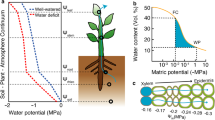Abstract
Water permeabilities of astomatous, isolated cuticular membranes (CM) of 24 different plants species were measured. Permeances varied from 1.7×10−11 m·s−1 (Vanilla planifolia leaf) up to 2.1×10−9 m·s−1 (Malus cf. domestica fruit) among different plant species, thus covering a range of over 2 orders of magnitude. Ranking of species according to permeances resulted in four distinct groups. The first group, of species with the lowest cuticular transpiration rates, included evergreen species growing in warm dry tropical climates (e.g. Vanilla planifolia and Monstera deliciosa leaves). The second class, with slightly higher water permeabilities, included evergreen species with typical scleromorphic leaf properties, adapted to a typical mediterranean type of climate with a dry period during the year (e.g. Citrus limon and Olea europaea leaves). The third group of species, where the highest leaf cuticular transpiration rates were observed, included deciduous species normally growing in a tempeate climate (e.g. Juglans regia and Forsythia suspensa leaves). Fruit cuticular membranes (CM) made up the fourth group (e.g. Capsicum annuum and Malus cf. domestica fruits), with even higher permeances than leaves of species from group 3. Thus, it appears that the plant species investigated show ecophysiological adaptations to the climatic demands of their natural habitats in cuticular water permeability.
Similar content being viewed by others
References
Baker EA (1982) Chemistry and morphology of plant epicuticular waxes. In: Cutler DF, Alvin KL, Price CE (eds) The plant cuticle. Academic Press, London, pp 139–165
Becker M, Kerstiens G, Schönherr J (1986) Water permeability of plant cuticles: permeance, diffusion and partition coefficients. Trees 1: 54–60
Cutler DF, Alvin KL, Price CE (1982) The plant cuticle. Academic Press, London
Geyer U, Schönherr J (1990) The effect of environment on permeability and composition of Citrus leaf cuticles. 1. Water permeability of isolated cuticular membranes. Planta 180: 147–153
Holloway PJ (1982) The chemical constitution of plant cutins. In: Cutler DF, Alvin KL, Price CE (eds) The plant cuticle. Academic Press, London, pp 45–85
Kamp H (1930) Untersuchungen über Kutikularbau und kutikuläre Transpiration von Blättern. Jahrb Wissens Bot 72: 403–465
Kolattukudy PE (1980) Biopolyesters of plants: cutin and suberin. Science 208: 990–1000
Kolattukudy PE (1981) Structure, biosynthesis, and biodegradation of cutin and suberin. Annu Rev Plant Physiol 32: 539–567
Lewis NG, Yamamoto E (1990) Lignin: occurrence, biogenesis and biodegradation. Annu Rev Plant Physiol Plant Mol Biol 41: 455–496
Martin JT, Juniper BE (1970) The cuticles of plants. Edward Arnold, London
Pisek A, Berger E (1938) Kutikuläre Transpiration und Trockenresistenz isolierter Blätter und Sproße. Planta 28: 124–155
Reynhardt EC, Riederer M (1991) Structure and molecular dynamics of the cuticular wax from leaves of Citrus aurantium L. J Phys D Appl Phys 24: 478–486
Reynhardt EC, Riederer M (1994) Structures and molecular dynamics of plant waxes. II. Cuticular waxes from leaves of Fagus sylvatica L. and Hordeum vulgare L. Eur Biophys J 23: 59–70
Sachs L (1984) Angewandte Statistik. Springer, Berlin Heidelberg New York
Santrucek J, Slavik B (1990) A method for separating cuticular and stomatal components of gas exchange by amphistomatous leaves. 1. Model solution. J Exp Bot 41: 795–802
Schönherr J (1976) Water permeability of isolated cuticular membranes: the effect of cuticular waxes on diffusion of water. Planta 131: 159–164
Schönherr J (1982) Resistance of plant surfaces to water loss: transport properties of cutin, suberin and associated lipids. In: Lange OL, Nobel PS, Osmond CB, Ziegler H (eds) Physiological plant ecology II. (Encyclopedia of plant physiology, vol 12B). Springer, Berlin Heidelberg New York, pp 153–179
Schönherr J, Lendzian K (1981) A simple and inexpensive method of measuring water permeability of isolated plant cuticular membranes. Z Pflanzenphysiol 102: 321–327
Schönherr J, Riederer M (1986) Plant cuticles sorb lipophilic compounds during enzymatic isolation. Plant Cell Environ 9: 459–466
Schreiber L, Schönherr J (1990) Phase transitions and thermal expansion coefficients of plant cuticles: the effects of temperature on structure and function. Planta 182: 186–193
Sitte P, Rennier R (1963) Untersuchungen an cuticularen Zellwandschichten. Planta 60: 19–40
Stålfelt M.G. (1956) Die cuticuläre Transpiration. In: Ruhland W (ed) Handbuch der Pflanzenphysiologie, vol 3. Springer, Berlin Heidelberg New York, 342–350
Takhtajan A (1969) Flowering plants. Origin and dispersal. Oliver and Boyd, Edinburgh
Walter H (1984) Vegetation und Klimazonen. Eugen Ulmer, Stuttgart
Walton TJ (1990) Waxes, Cutin and suberin. Meth Plant Biochem 4: 105–158
Author information
Authors and Affiliations
Corresponding author
Rights and permissions
About this article
Cite this article
Schreiber, L., Riederer, M. Ecophysiology of cuticular transpiration: comparative investigation of cuticular water permeability of plant species from different habitats. Oecologia 107, 426–432 (1996). https://doi.org/10.1007/BF00333931
Received:
Accepted:
Issue Date:
DOI: https://doi.org/10.1007/BF00333931




